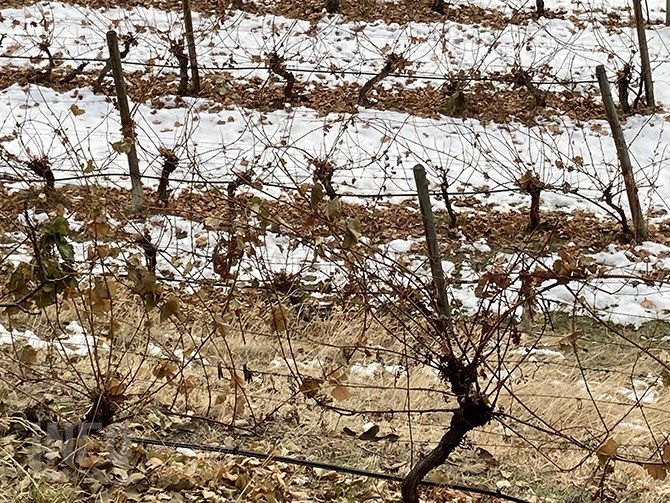Growing grapes in Okanagan is 'like Russian roulette' these days: winemaker

It’s clear that the 2024 wine grape crop has been destroyed by cold weather throughout the Okanagan.
But how to cope with that impact is complicated by the fact that while buds are so damaged that they won’t produce fruit this year, it’s not known how many of the plants are dead.
“The roots are going very deep so, sometimes, if the top is dead, we have a renewal from the bottom and maybe we can retrain the plant that way,” Severine Pinte, the winemaker and viticulturist at Le Vieux Pin Winery in Oliver and LaStella Winery in Osoyoos, told iNFOnews.ca.
Back-to-back cold spells over two winters have wiped out a majority of the grape crop but it’s still not known how many plants actually died.
READ MORE: Okanagan grape harvest wiped out for 2024
Pulling out intermittent dead plants and replacing them doesn't work well so growers have to decide what level of plant kill is tolerable before pulling out and replanting entire blocks, Pinte said.
Some plants may take a couple of years to recover but it could also take a year or two for the roots to die. That makes it tough to know whether to replant or continue on hoping for the best.
“Some of the plants we chose to keep this year, maybe they won’t make it because they’re too damaged inside,” Pinte said. “There’s no way to look inside the plant so we have very little feedback on how the vines are surviving those cold damages. It’s like Russian roulette.”
“I am very hopeful for our vineyard,” David Paterson, general manager and winemaker at Tantalus Vineyards, told iNFOnews.ca. “We’ve been hilling up around the graft union of the vine for awhile now and we expect to see good healthy shoots come out of the bottom.
“We’re very hopeful that will happen and then we’re just regenerating those vines for one year. By the following year we would see, probably, what would be 40% or 50% of a normal crop because you don’t rebuild an entire vine in one year.”
It will come down to individual wineries making individual business decisions on how they proceed.
“Some might prefer that 30% are still growing and try to keep a crop from that, rather than removing everything and replanting,” Pinte said. “But some businesses might say: ‘OK. I’m just pulling the block and I’m going to replant.’”
It will be May or June before growers will have a good idea of how much plant kill there was from the January 2024 cold snap that wiped out this year’s crop.
READ MORE: Don’t count Okanagan wine industry out just because this year’s crop is gone
Pinte has been making wine for 28 years and has never seen such devastating back to back cold events.
“We have lost vines from last year,” she said. “We will lose vines this year and, all the vines that survived, how strong are they? Are they going to be able to produce the same amount we do usually?
“There are a lot of unknowns because these are such extreme events and we don’t have the answers. We are actively looking. There’s a lot of research going on. There’s a lot of data being collected. By collecting data we can try to, over the years, compare and try to use that data to make some decisions. But it’s very hard.”
Even if growers decide to replant and order new vines, those take two years to grow in nurseries (mostly in other parts of Canada or in the U.S.) so there isn’t likely to be much available to plant until 2026.
It takes another three years for those plants to produce a viable crop.
Given how hard their revenues were hit in 2023, it’s tough to come up with the $40,000 per acre needed to replant, even if they can get new vines.
Growers are still waiting to hear from the province if there will be money for a replant program from the 2022 kill off.
But, right now, it’s a matter of survival.
“The industry is actively working to get the government aware of the very disastrous situation a lot of growers are in and the need to get some help so we can survive and the industry’s not killed,” Pinte said. “Then, after that, we have to think about replant. But, right now, I think the emergency funds would be the first thing to do to help people survive this year and maintain the vineyard so it can produce next year.”
Even though there's no crop, that doesn’t mean the work and expense ends for the growers.
“The vineyard, in itself, didn’t make much money last year because we had barely any crop,” Pinte said. “But, we still had to manage them, take care of pruning, manage the canopy, keep on spraying to eliminate the mildew if we have a mildew year. There are a lot of things that need to keep happening despite the fact that we have no money coming in.”
The crop damage has also caused a lot of stress for workers.
“We all have a very high level of anxiety in our staff, everywhere in the valley,” Pinte said. “We all need to be very cognizant of that and staying positive because there are a lot of mental illness issues happening all over the place.”
To contact a reporter for this story, email Rob Munro or call 250-808-0143 or email the editor. You can also submit photos, videos or news tips to the newsroom and be entered to win a monthly prize draw.
We welcome your comments and opinions on our stories but play nice. We won't censor or delete comments unless they contain off-topic statements or links, unnecessary vulgarity, false facts, spam or obviously fake profiles. If you have any concerns about what you see in comments, email the editor in the link above. SUBSCRIBE to our awesome newsletter here.


